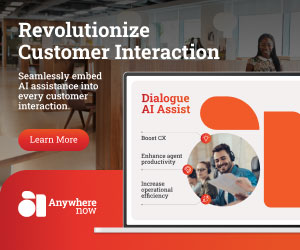Adrian Bethell notes how there is more to a multichannel customer experience than just configuring some software and updating your website.
When interacting with customers, there is no doubt that multichannel customer experience needs to be embraced. It’s equally important to understand that we must approach it with caution, as failing to do so could disappoint our customers.
While a multichannel customer experience can help meet customers’ desires for easy access, one of the easiest ways to frustrate our customers is by asking them the same questions – over and over again.
When launching new channels in the contact centre, ensure that the left hand knows what the right hand is doing. If a customer tells you their ‘life history’ on the phone in the morning, they will likely become irate when asked for the same information in a webchat later in the day.
Before launching a new channel, businesses should answer this question honestly: do you deliver a consistent service across the channels that you’re already managing?
For example, if a team of mystery callers were to call the contact centre across these channels – at different times and with identical scenarios – would their treatment be standardised?
Misconceptions About the Multichannel Customer Experience
As one may expect, the multichannel customer experience supports more than one customer communication channel. It’s entirely different from just publishing an additional 800-number and having the calls arrive at your existing inbound team.
It is horses for courses, and different customers will have their own preference when it comes to which channel they use most – but they are united by their contempt for poor service. Treat each channel with the same expectations of service quality.
Here are four more tips to avoid the common misconceptions of multichannel:
1. You must ensure that adding the new channels to your contact centre results in a net benefit, and that existing channels do not suffer.
2. Don’t underestimate the detrimental effect of misleading customers through an expectation of communication through specific channels that is then not met. Or by opting into a channel of communication that is not best suited to the purpose of your engagement or the needs of your customer.
To avoid confusion, ensure the purpose of each channel is clarified in order to align expectations.
3. Monitor customer behaviour across different channels to assess their complete customer journey.
Most customers use more than one channel, sometimes at the same time, and this doesn’t need to negatively affect your First Call Resolution (FCR) score.
4. Fully utilise social media and maximise your brand presence; poor management of social media can have major impact on brand image.
For some businesses this may still be a new tool, but it’s evolving fast and there are many creative ways to make it work for you.
Ultimately, as a key line of customer communication, from complaints to queries, social media must be managed confidently – and taken seriously.
Five Reasons to Approach a Multichannel Customer Experience
1. Customers Want to Communicate with Businesses in a Variety of Ways
Companies should aim to communicate with a customer in a way that suits their individual needs and preferences.
More direct customers may prefer human contact so may opt for voice channels, while more tech savvy, busy or even shy customers may prefer digital channel options.
In order to appeal to the whole range of customers and organically nourish these relationships, a multichannel approach is the only way to impress.
2. Contacts Handled via Different Channels Can Be Cheaper Than by Voice
From a business point of view, email, chat, SMS, and social media can be less expensive per interaction than a call, so there’s a strong business case for a multichannel approach.
3. Agent Engagement Is Greater if They Handle More Than One Channel
A multichannel customer experience is also more engaging for contact centre agents. A variety of channels makes the workload varied and reduces staff turnover.
Adding to the skill set and experience of the workforce, along with boosting engagement, results in better customer experience, increased loyalty, and repeat business.
4. It Allows the Contact Centre to Juggle Resources
Staffing your contact centre appropriately for multiple channels allows you to move resources in real time to a channel that’s experiencing a spike in volume. If you’re only offering one channel, you have a limited ability to juggle resources to match needs.
Often, the quality assurance programme is the first to suffer when freeing up resources to handle peaks.
5. Chats Can Be Automated With the Help of Virtual Agents
Virtual agents can refer to FAQs to answer questions in webchat without using live-agent resources.
While this is an asset for agents, businesses need to be aware of the well-read customers who may have already gone through this resource and require more detail – or more of a human touch.
To manage expectations, clearly differentiate between experiences and the type of interactions required or desired.
Reasons to Approach Multichannel Customer Experience With Caution
Change is often hard. If different success metrics, agent profiles and processes are appropriate, this may require a cultural change.
This in turn may call for new philosophies to encourage alternative behaviours, to drive new hiring strategies and ultimately a refreshed workforce.
1. Technology Can Be a Limiting Factor
Consider what happens to your contact centre agent’s desktop when multiple new channels are added.
This shouldn’t mean juggling three different tools at once. Ensure that channels are integrated with an omnichannel contact centre platform that enables the delivery of uniform information, consistently and seamlessly.
With the right level of integration, a contact centre platform should help to report, forecast and plan resources; monitor quality; and remain compliant with appropriate legislation.
2. Audience Demographic Is Important
Understand the needs and demographic of your audience – use channels that suit them.
Don’t risk alienating customers by introducing and enforcing communication through channels that do not suit their needs.
Enable a smooth customer journey via all channels with a consistency that leaves no customers in the dark.
3. Agents Don’t Learn How to Multi-Task Overnight
Don’t fall into the multi-tasking trap as you switch to the multichannel.
Resource the contact centre adequately to ensure maximum quality of service and no dip in First Contact Resolution (FCR), which could ultimately lead to more customer engagement and further strain on the centre.
Author: Robyn Coppell
Published On: 27th Jul 2017 - Last modified: 5th Mar 2019
Read more about - Archived Content, Genesys

































